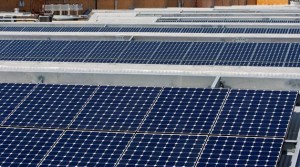
The International Solar Alliance, a treaty-based inter-governmental organization of over 120 nations. The International Solar Alliance, launched at the end of UN Climate Change Conference 2015 or COP21 in Paris by Fracois Hollande, President of France and Narendra Modi, Prime Minister of India aims to exploit potential of power and cut dependence on fossil fuels. The alliance was 1st proposed by Prime Minister Narendra Modi ahead of COP21. The framework agreement for International Solar Alliance which is separate from the UN-mandated climate change talks held every year; opened for signatures at COP22 in Marrakech, Morocco in November 2016, and over 120 countries have signed till today. ISA will become operational the moment at least 15 countries have ratified it. ISA framework states that member countries take coordinated steps via solar power promotional programmes to boost demand for finance, solar technological innovation, research and development, as well as capacity building. India was one of the first countries to ratify ISA.
ISA is headquartered in India at the National Institute of Solar Energy (NISE) in Gwalpahari, Gurugram, Haryana. The alliance also called International Agency for Solar Policy and Application (IASPA) focuses on solar power utilization. The alliance aims to help developing countries address the climate change concerns and opt for a low-carbon environment. India as one of the founding members has pledged to install 100GW of renewable energy by 2022 as well as cut carbon emission by 33–35% by 2030. India endorsed the use of sustainable environment, clean energy, public transport, and climate adaptive agriculture through this initiative. India also launched a tool called IESS 2047 (India Energy Security Scenarios 2047 calculator) to explore the potential of future energy scenarios for India.
Importance of Tropic of Cancer and Tropic of Capricorn
The area between the Tropic of Cancer and Tropic of Capricorn called the tropical zone that receives the maximum sunlight. The Tropic of Cancer is the northernmost point from which the Sun can pass directly overhead. Same is the case with Tropic of Cancer where sun reaches the southernmost point while passing directly overhead. As such nations that are completely or partially located between Tropic of Cancer and Tropic of Capricorn are part of it including Chile; Argentina; Ethiopia; Brazil; India; Niger; Cambodia; UK; Brazil; Congo; Bangladesh; Dominican Republic; Mexico; Peru; Australia; New Zealand; Guinea; Tanzania; Tuvalu; Mali; Nauru; Burkina Faso; Madagascar; Paraguay; China among others. The USA after initial opposition also became a part of the alliance. The alliance came into existence in Marrakech, Morocco in November 2016, on the sideline of Marrakech Climate Change Conference or COP 22.
Solar Power & Progress of ISA
As the importance of solar energy came to fore in the last decade or so due to sharp drop in prices of production of electricity through solar photovoltaic cells; it has prompted countries to seek alternatives in solar power so as to move away from dependence of non-renewable sources of energy like coal, oil and gas, that are major cause of pollution and resulting ill effects on the climate. As solar energy grew more competitive; total installed solar energy capacity across the world has grown by nearly 8 times during the same period. As such it was important to capitalize on the power of sun and to maximize the potential of solar power. This resulted in the creation of ISA and finances were secured to develop and establish solar power projects
As such India with active support from France invited other solar power rich nations to help in creating infrastructure to implement solar power projects. The alliance is committed to bring down the cost of solar power so as to make it affordable for even those people who are living in remote and inaccessible communities. The alliance intends to undertake research & development; develop demonstration facilities to make solar power equipment within developing nations. On June 30, 2016, the alliance signed a MoU with World Bank to accelerate finances for solar power projects. The World Bank is set to mobilize over US$ 1000 billion by 2030, to meet ISA’s goal for deployment of solar energy. ISA aims to focus on 5 key areas such as:-
- Promote solar technologies, new business models and investment.
- Formulate projects and programmes to help promote solar application.
- Develop innovative financial mechanisms to reduce costs.
- Develop a common knowledge e-portal.
- Facilitate capacity building for among member countries.
The ISA seeks to boost the global demand for solar power that will help reduce prices of solar power deployment. It also seeks to promote standardisation of equipments and processes used for generating solar power as it will cut the cost of equipment and help the world transition from high carbon emitting & polluting society to a low-carbon emitting greener one. India as one of the founder members of ISA has offered to contribute Rs 175 crore or US $27 million for setting up the ISA corpus fund as well as meet the cost of ISA secretariat in New Delhi, for first 5 years. Two public sector undertakings, namely Solar Energy Corporation of India & Indian Renewable Energy Development Agency, have decided to contribute US$1 million each towards the corpus fund. ISA is expected to give India opportunity to take centre stage in fight against climate change.
Key Facts & Figures
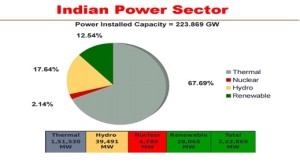
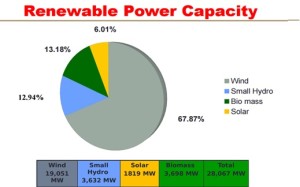
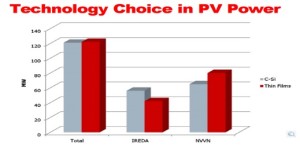
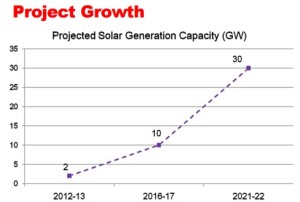
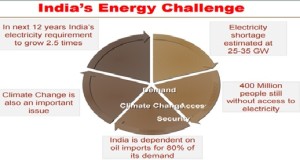
India’s National Solar Mission & ‘Solar India’ Brand
The Jawaharlal Nehru National Solar Mission or simply ‘National Solar Mission’ is an initiative of Government of India and State Governments for promote of ecologically sustainable growth while addressing India’s energy security needs. While launching the National Action Plan on Climate Change on June 30, 2008, Prime Minister of India, Dr. Manmohan Singh said that we must shift from economic activity based on fossil fuels to one based on non-fossil fuels; and stop reliance on non-renewable and depleting energy sources to renewable resources. He said for this to happen the sun the original source of all energy plans central role.
He also said ‘The National Action Plan on Climate Change points out that India as a tropical country, enjoys sunshine for longer hours per day with greater intensity. Solar power as such has potential to be the mainstay for future energy needs. It also has the advantage of allowing decentralized distribution of energy, thereby empowering people at the grassroots level”. Based on this vision Jawaharlal Nehru National Solar Mission was launched under the brand name of “Solar India”.
The National Solar Mission is one of the 8 Missions under National Action Plan on Climate Change that will work closely with state governments, power utilities/regulators, local self governing bodies to ensure that the activities and policy framework are implemented effectively. As it is known solar energy is environment friendly as it has zero emissions while generating copious amount of electricity or heat without polluting the environment. The Jawaharlal Nehru National Solar Mission was started with an objective to build on this and make India as a global leader in solar power. National Solar Mission is expected to achieve its target in 3 phases; Phase 1 spanning 11th Plan and 12th Plan (up to 2012-13), Phase 2 spanning 12th Plan (2013-17) and Phase 3 spanning 13th Plan (2017-22).
The mission aims to create a policy and regulatory environment that will provide a predictable incentive structure to enable large-scale investment in solar energy as well as encourage technical innovation resulting in lowering of cost over a period of time. However, immediate aim of National Solar Mission is to setup suitable environment for solar technology penetration across India at centralized and decentralized level. Main objective of National Solar Mission is to:-
- Establish India as a global leader in solar energy, by creating the policy conditions for its diffusion across India.
- Achieve grid parity by 2022 and parity will coal power by 2030.
- Focus on setting up an environment for solar technology at the centralized and decentralized level.
- Adopt a 3-phase approach from 2010 to 2022; while 1st phase is to focus on promoting off-grid systems to reach population with no access to commercial energy; the 2nd phase is to aggressively up scale solar energy penetration across India.
To achieve the above mentioned aims, the National Solar Mission is targeting the following:-
- Creation of an enabling policy framework to deploy 20,000 MW of solar power by 2022.
- Ramp up capacity of grid-connected solar power generation to 1000 MW within 3 years, ie. by 2013; reach 3000 MW by 2017 via mandatory use of renewable purchase obligation by utilities backed by a preferential tariff & if possible reach 10,000MW by 2017. The target of 20,000 MW for 2022 is however dependent on ‘learning’ from the two phases, which if successful, could lead to conditions of grid-competitive solar power.
- Create favourable conditions to boost solar manufacturing capability, in particular solar thermal for indigenous production.
- Develop programmes for off-grid systems touching 1000 MW by 2017 and 2000 MW by 2022.
- Target 15 million sq. meters solar thermal collector area by 2017 and 20 million by 2022.
- Deploy 20 million solar lighting systems for people in rural areas by 2022.
Separate Targets for Other Applications
- Rooftop PV Programme – 1000 MW
- Energy Access – 20,000 (Villages/hamlets/basti/padas)
- Off-Grid Lighting Systems – 10 lakhs
- Solar Cities – 15 (In addition to existing target of 60 cities)
- Solar Water pumps – 25,000 Systems
- Telecom Towers – 25,000 Systems
- Solar Water Heating Systems – 8 Million Sq.m of Collector area
- Solar Cooker & Steam Generating Systems – 50,000 Systems
- Industrial Process heat application – 400 , 250 Sq.m each on an average
- Manufacturing – 4/5 GW Capacity
- Solar Monitoring & Assessment – 60 Monitoring Stations
- Human Resource Development – 1 Lakh trained & Specialized personnel
- Solar Parks (250 MW capacity and Land area of 600 hectare) – 5 Nos.
- Hybrid Systems
National Solar Mission Roadmap

National Solar Mission Recommendations
National Solar Mission to achieve its target of installed capacity, recommends the following:
- Local Demand Creation: The 20 GW plan must be supported with right level of incentives for solar power generation backed by large government pilot/demonstration programs to make Indian solar power market attractive for solar manufacturers.
- Financing & Incentives: SEZ like incentives ought to be provided to the solar PV and related equipment manufacturing units that may include:
o Zero import duty on purchase of capital equipment, raw materials and exemption on excise duty.
o Loans on low interest rate and loans to be treated as priority sector lending.
o Special Incentive Package to those interested in setting up integrated manufacturing plants; including poly silicon material to solar modules; and thin film based module manufacturing plants.
o Solar components are to be covered under star rating program of Bureau of Energy Efficiency to ensure high quality of products.
- Ease To Do Business: Central government after consulting the state governments must create a single window clearance mechanism for all related permissions.
- Infrastructure & Ecosystem Enablers: Creation of 2-3 large scale solar manufacturing tech parks near major urban cities as well as ports and airports to ensure access to raw materials (imported if needed) and quality engineering talent. The parks are to include not just manufacturing units but staff houses, offices, and research facilities with 24/7 water and power supply.
- Duty Concessions: concessions/exemptions on custom and excise duty is need of the hour as that will help manufactures easily access specific capital equipment & components, critical materials.
National Solar Mission R&D Objectives
National Solar Mission in order to achieve its target of installed capacity by 2022, needs to follow a roadmap for R&D, such as:-
i) Conduct basic research for development of innovative materials, processes and applications.
ii) Carry out applied research to improve existing processes, materials, and technology for enhanced performance, durability and cost competitiveness
iii) Validate technology and demonstrate projects for field evaluation of different configurations so as to obtain feedback on the performance, operability and costs,
iv)Develop R&D infrastructure via. PPP model
v) Support incubation and start ups.
National Solar Mission HRD Objectives
National Solar Mission in order to achieve its target needs to have strong base of professionals and technicians with relevant expertise. As such as a number of steps need to be taken such as:-
- IITs and other engineering colleges are to design and develop specialized courses in solar energy, with financial assistance from central/state government.
- Establish a fellowship programme to train selected engineers/technologies and scientists in solar energy by training them at world class institutions abroad.
- Set up National Centre for Photovoltaic Research and Education at IIT, Mumbai utilizing resources from its Department of Energy Science and Engineering and the Centre for Excellence in Nano-Electronics.
Implementation & Management of National Solar Mission
The National Solar Mission will be implemented/monitored by an autonomous Solar Energy Authority and/or autonomous and enabled solar mission, embedded within the Ministry of New and Renewable Energy. The management of the mission and its objectives will be carried out by:-
- A fully empowered Mission Steering Group, chaired by the Minister for New and Renewable Energy and composed of representatives from all relevant Ministries and other stakeholders to authorize any modifications / deviations in the scheme.
- A fully empowered Mission Executive Committee, chaired by Secretary, Ministry of New and Renewable Energy to periodically review the progress of projects green lighted by Mission Steering Group.
- A fully empowered Solar Research Council headed by an eminent scientist to advise the Mission on all R&D, technology and capacity building related matters.
- An Industry Advisory Council to advise on matters related to industrial development, technology transfer/absorption/joint ventures, incentives and investment related matters.
- A Mission Director, of Additional Secretary rank will head the Mission secretariat and will be responsible for day-to-day functioning of the mission as laid out in a time bound manner.
All said while the International Solar Alliance is an international body meant to promote solar power in the world, National Solar Mission is involved in the expansion of solar power in India with efforts to boost, finances, research and development and sourcing of raw material and production of finished products of highest quality as per international standards. But persistent problems still remain such as: –
- Reluctance to accept change from coal to solar in private sector.
- Difficulty in arranging finances specifically for solar projects.
- Lack of skilled and trained labour.
- Lack of research and development activities.
- Reluctance to adopt new technological innovations.
- Difficulty in persuading individual users to opt for solar power.
Despite such constraints, the government is trying very hard to achieve its target within the stipulated time and meet the target. However, efforts are on to boost the acceptance of solar power as a renewable and cheap alternative to coal / oil based power that is not just polluting sources but are also non-renewable. As the per unit cost of power purchase for solar power generated is expected to drop to an all-time low in the coming months if not years; it can be expected that the targets set under the National Solar Mission will be certainly achieved even though a slight delay is expected.
About Vivaan Solar
Vivaan Solar as a EPC contractor is a solar PhotoVoltaic system installer & integrator. We have installed 60 MW solar park in Madhya Pradesh, 5 MW in Punjab, 8 MW in Uttarakhand and an upcoming park in Karnataka. As MNRE accredited channel partner for Rooftop, we recently won contract to install 5 MW rooftop solar power project at 4 major railway stations of NCR. We also won contract to install 2 MW rooftop solar power project at Rail Wheel Factory, Yelahanka near Bengaluru, Karnataka. We are an MNRE accredited channel partner. For more info you can visit our website: www.vivaansolar.com or mail- info@vivaansolar.com.
Sources:
http://www.iitj.ac.in/CSP/material/JNNSM-Final.pdf
http://www.indiaenvironmentportal.org.in/files/mission-document-JNNSM.pdf

